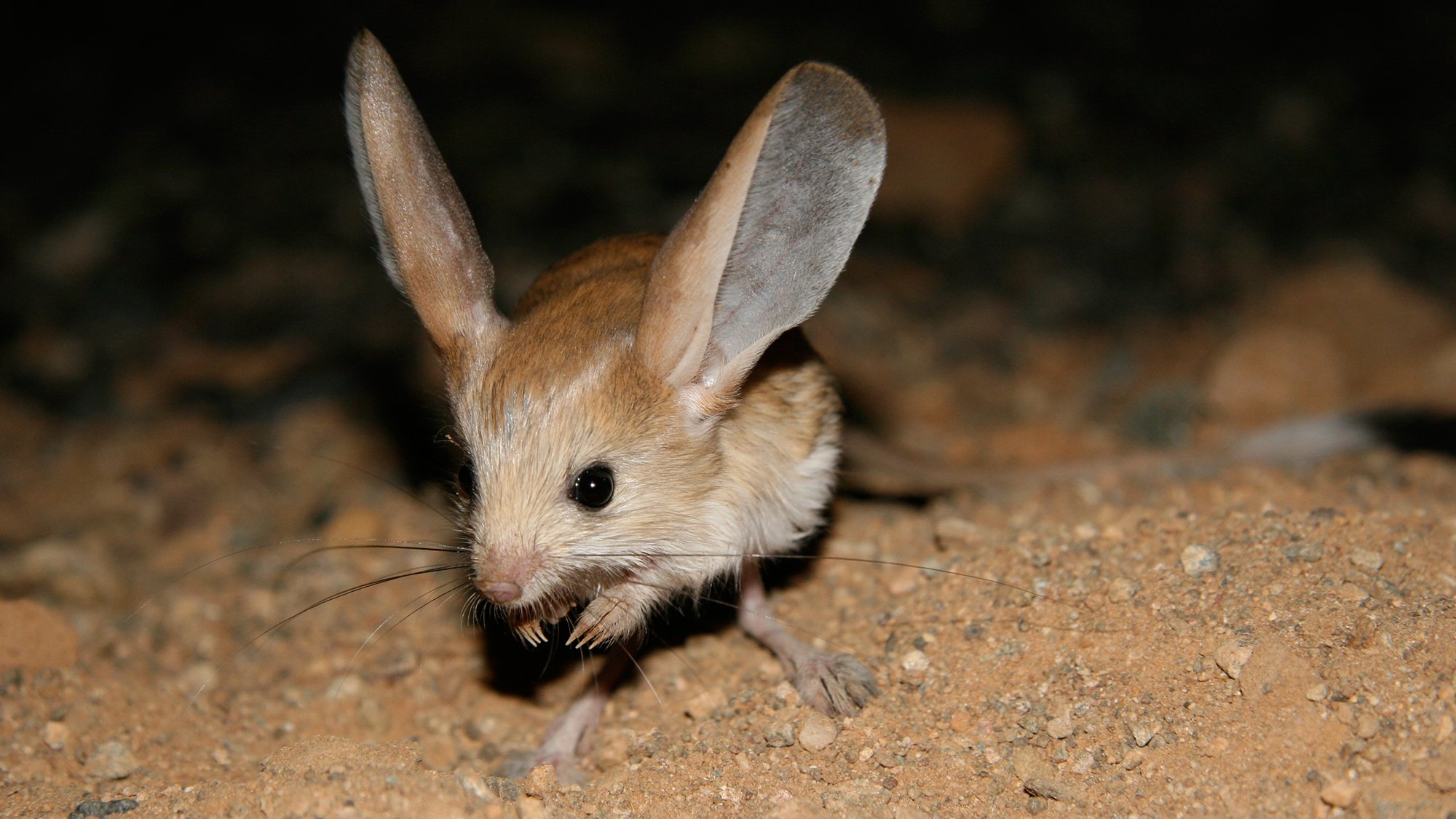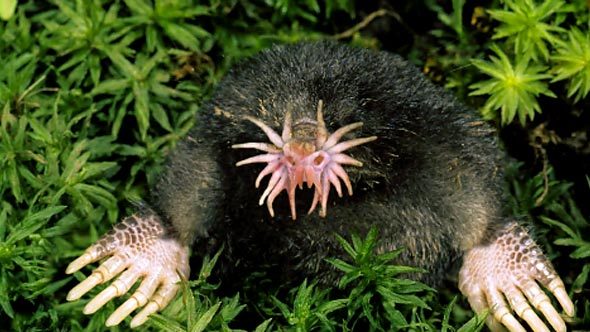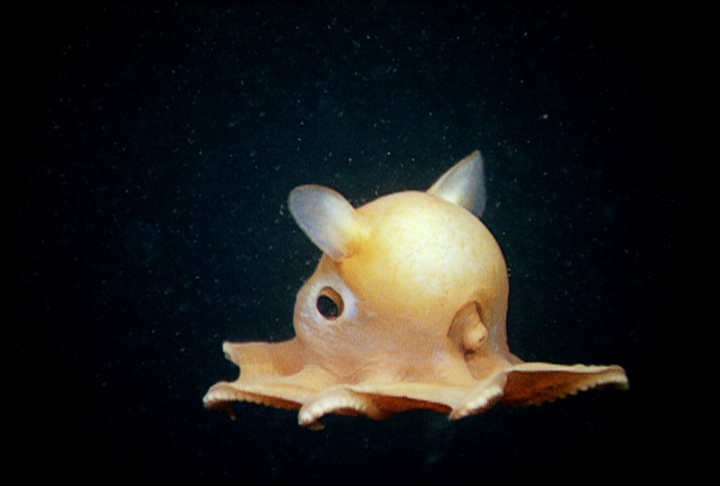Most of us don’t grasp the variety of animals species that inhabit the Earth today, and some even get surprised as they find out there’s an animal they haven’t heard of before. But seriously now – out of 1,367,555 identified non-insect animal species that live on Earth today, how do you expect to know every single one of them? To put it into perspective, take into account that this number represents only 1% of all animal species that ever lived!
Scientists themselves keep discovering new species every year and admit that modern science is not familiar with all existing animals. This leaves room to such unique and even bizarre discoveries and collected in this post! Inspired by reddit, we put together a selection of such unheard-of creatures as a Dumbo Octopus, Pink Fairy Armadillo, Star-Nosed Mole and many more. Warning – not all of them are super cute and fluffy!
1-The Proboscis Monkey
The proboscis monkey (Nasalis larvatus) or long-nosed monkey, known as the bekantan in Indonesia, is a reddish-brown arboreal Old World monkey that is endemic to the southeast Asian island of Borneo.
This species co-exists with the Bornean orangutan. It belongs in the monotypic genus Nasalis, although the pig-tailed langur has traditionally also been included in this genus.
The monkey also goes by the Malay name monyet belanda ("Dutch monkey"), or even orang belanda ("Dutchman"), as Indonesians remarked that the Dutch colonisers often had similarly large bellies and noses.
This species of monkey is easily identifiable because of its unusually large nose.
2-Blob Fish
The blobfish (Psychrolutes marcidus) is a deep sea fish of the family Psychrolutidae. It inhabits the deep waters off the coasts of mainland Australia and Tasmania, as well as the waters of New Zealand.
Blobfish are typically shorter than 30 cm. They live at depths between 600 and 1,200 m (2,000 and 3,900 ft) where the pressure is 60 to 120 times as great as at sea level, which would likely make gas bladders inefficient for maintaining buoyancy.[1] Instead, the flesh of the blobfish is primarily a gelatinous mass with a density slightly less than water; this allows the fish to float above the sea floor without expending energy on swimming. Its relative lack of muscle is not a disadvantage as it primarily swallows edible matter that floats in front of it such as deep-ocean crustaceans.
Blobfish are often caught as bycatch in bottom trawling nets. Scientists now fear the blobfish could become an endangered species because of deep-ocean trawling.
3-Gobi Jerboa

The Gobi Jerboa (Allactaga bullata) is a species of rodent in the Dipodidae family. It is found in China and Mongolia. Its natural habitats are temperate grassland and temperate desert.
The Gobi jerboa (Allactaga bullata) was discovered in 1925 by Glover Morrill Allen. It is found in the Gobi Desert located in northern and northwestern China, as well as in southern Mongolia, and is considered to be the most “desert loving” out of all Gobi rodents (Smith and Xie 2008). Allen first examined an adult male gobi jerboa from Tsagan Nor, Outer Mongolia, which was collected on July 5, 1922 by the Central Asiatic Expeditions and housed at the American Museum of Natural History (Allen 1925). Allen further compared the species Allactaga sibirica annulata and Allactaga sibirica sibirica, to the gobi jerboa because they are all sympatric species. Allen examined forty specimens collected from different regions of Mongolia, and found that while the gobi jerboa was similar in color and appearance to A. sibirica annulata, by exhibiting the same grayer and buffier phases, the gobi jerboa has shorter and broader ears, smaller hind feet, and a much larger globular audital bullae (nearly three times the size), which differentiates it from the A. sibirica annulata. The gobi jerboa was differentiated from A. sibirica sibirica because of its enlarged and globular auditory bullae, and its nearly vertical upper incisors (Allen 1925). Today, there have been 163 recorded occurrences of the gobi jerboa, however there is currently no known data that examines its population status (The Global Biodiversity Information Facility 2013 and Batsaikhan et. al. 2008).



Lampreys (sometimes also called lamprey eels) are any jawless fish of the order Petromyzontiformes. The adult lamprey may be characterized by a toothed, funnel-like sucking mouth. The common name "lamprey" is probably derived from Latin lampetra, which may mean "stone licker" (lambere "to lick" + petra "stone"), though the etymology is uncertain.
Currently there are about 38 known extant species of lampreys. Although they are well known for boring into the flesh of other fish to suck their blood, in fact only a minority do so; only 18 species of lampreys are actually parasitic. The lampreys are a very ancient lineage of vertebrates, though their exact relationship to hagfishes and jawed vertebrates is still a matter of dispute.
7-Dugong


Scientists themselves keep discovering new species every year and admit that modern science is not familiar with all existing animals. This leaves room to such unique and even bizarre discoveries and collected in this post! Inspired by reddit, we put together a selection of such unheard-of creatures as a Dumbo Octopus, Pink Fairy Armadillo, Star-Nosed Mole and many more. Warning – not all of them are super cute and fluffy!
1-The Proboscis Monkey
The proboscis monkey (Nasalis larvatus) or long-nosed monkey, known as the bekantan in Indonesia, is a reddish-brown arboreal Old World monkey that is endemic to the southeast Asian island of Borneo.
This species co-exists with the Bornean orangutan. It belongs in the monotypic genus Nasalis, although the pig-tailed langur has traditionally also been included in this genus.
The monkey also goes by the Malay name monyet belanda ("Dutch monkey"), or even orang belanda ("Dutchman"), as Indonesians remarked that the Dutch colonisers often had similarly large bellies and noses.
This species of monkey is easily identifiable because of its unusually large nose.
2-Blob Fish
Blobfish are typically shorter than 30 cm. They live at depths between 600 and 1,200 m (2,000 and 3,900 ft) where the pressure is 60 to 120 times as great as at sea level, which would likely make gas bladders inefficient for maintaining buoyancy.[1] Instead, the flesh of the blobfish is primarily a gelatinous mass with a density slightly less than water; this allows the fish to float above the sea floor without expending energy on swimming. Its relative lack of muscle is not a disadvantage as it primarily swallows edible matter that floats in front of it such as deep-ocean crustaceans.
Blobfish are often caught as bycatch in bottom trawling nets. Scientists now fear the blobfish could become an endangered species because of deep-ocean trawling.
3-Gobi Jerboa

The Gobi Jerboa (Allactaga bullata) is a species of rodent in the Dipodidae family. It is found in China and Mongolia. Its natural habitats are temperate grassland and temperate desert.
4-Yeti Crab

Is a crustacean discovered in 2005 in the South Pacific Ocean. This decapod, which is approximately 15 cm (5.9 in) long, is notable for the quantity of silky blond setae (resembling fur) covering its pereiopods (thoracic legs, including claws).
5-Star-Nosed Mole

The star-nosed mole (Condylura cristata) is a small mole found in moist low areas of eastern Canada and the northeastern United States, with records extending along the Atlantic coast as far as extreme southeastern Georgia. It is the only member of the tribe Condylurini and the genus Condylura.
The star-nosed mole is easily identified by the twenty-two pink fleshy appendages ringing its snout, which is used as a touch organ with more than 25,000 minute sensory receptors, known as Eimer's organs, with which this hamster-sized mole feels its way around. With the help of its Eimer's organs, it may be perfectly poised to detect seismic wave vibrations.
6-Lamprey

Currently there are about 38 known extant species of lampreys. Although they are well known for boring into the flesh of other fish to suck their blood, in fact only a minority do so; only 18 species of lampreys are actually parasitic. The lampreys are a very ancient lineage of vertebrates, though their exact relationship to hagfishes and jawed vertebrates is still a matter of dispute.
7-Dugong

The dugong (/ˈduːɡɒŋ/, /ˈdjuːɡɒŋ/; Dugong dugon) is a medium-sized marine mammal. It is one of four living species of the order Sirenia, which also includes three species of manatees. It is the only living representative of the once-diverse family Dugongidae; its closest modern relative, Steller's sea cow (Hydrodamalis gigas), was hunted to extinction in the 18th century. The dugong is the only strictly marine herbivorous mammal, as all species of manatee use fresh water to some degree.
The dugong is the only sirenian in its range, which spans the waters of some 40 countries and territories throughout the Indo-West Pacific. The dugong is largely dependent on seagrass communities for subsistence and is thus restricted to the coastal habitats which support seagrass meadows, with the largest dugong concentrations typically occurring in wide, shallow, protected areas such as bays, mangrove channels, the waters of large inshore islands and inter-reefal waters. The northern waters of Australia between Shark Bay and Moreton Bay are believed to be the dugong's contemporary stronghold.
8-Dumbo Octopus

Is a genus of pelagic umbrella octopus that live in the deep sea. Prominent ear-like fins protrude from the mantle just above their lateral eyes. They have a U or V shaped shell in their mantle which gives them a bell shaped appearance. Some species are short, squat and yellow, while others resemble a jellyfish with one big brown walking shoe. Some have suckers, in addition to spines, on all 8 webbed arms while others look like a regular octopus with the addition of blue or other colored "ears"

0 commentaires :
Enregistrer un commentaire